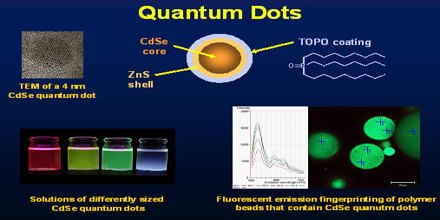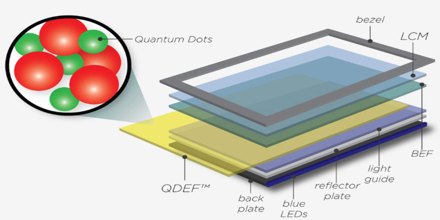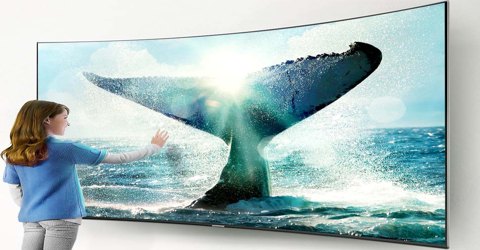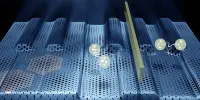Quantum Dot Display

The idea of using quantum dot as a light source emerged in the 1990s. Early applications included imaging using QD infrared photodetectors, light emitting diodes and single-color light emitting devices. Starting from early 2000, scientists started to realize the potential of developing quantum dot for light sources and displays.
It was widely tipped that Apple would use quantum dots in the iPhone 6 way back in 2014. It didn’t turn out that way in the end, of course, but we have seen the technology cropping up in the Amazon Kindle Fire HDX 7 and HDX 8.9 tablets.
Indeed, at CES 2016, Samsung has revealed an exciting new flagship range of SUHD TV sets, all of which contain quantum dot displays.
And it’s important because quantum dots is one of the technologies that’s driving the creation of high dynamic range TVs (HDR) and the creation of the new Ultra HD Premium standard.
What are Quantum Dots?
Simplifying things greatly (as this guide aims to do, mostly), quantum dots are incredibly small particles. It is an experimental type of display technology. They range between 2 to 10 nanometers in diameter, which is equivalent to 50 atoms. Yes, atoms. You can’t measure these things using your old school shatter proof ruler. It’s this small size that gives quantum dots the unique properties to improve our tech.

The colour light that a quantum dot emits is directly related to its size; smaller dots appear blue, larger ones more red. In LCD screens they’re applied as a way of eliminating the need for White LED backlights and colour filters.
As Dr. Raymond M. Soneira, President of DisplayMate, explains: “Instead of using existing White LEDs (which have yellow phosphors) that produce a broad light spectrum that makes it hard to efficiently produce saturated colors, Quantum Dots directly convert the light from Blue LEDs into highly saturated narrow band primary colors for LCDs.”
Benefits of Quantum Dots
Higher peak brightness – One of the reasons TV manufacturers like quantum dots is that they allow them to produce TVs with much higher peak brightness. This opens up some interesting possibilities, such as enabling support for ‘high dynamic range’ TVs that support standards such as Dolby Vision.
Better colour accuracy – Another big benefit of quantum dots is improved colour accuracy. The light produced by quantum dots is so closely tied to their size that they can be tuned very precisely to emit the exact kind of light needed. This means purer, cleaner whites and more precise colours.
Higher colour saturation – One advantage, though some might call it a disadvantage in some contexts, of OLED screens over LCDs is colour saturation. Colours on OLED screens simply ‘pop’ more due to the huge colour gamut OLED screens can achieve. Quantum dots can, according to Dr. Soneira, increase the colour gamut on LCD screens by in the region of 40 to 50 per cent.
Improved battery life in mobile gadgets – One of the contradictions of modern tech is that people say they want better battery life, but when it comes to it they’ll choose a slimmer, sleeker and ‘sexier’ phone over a chunky one with better battery life. Some of you reading this will be jumping up and down saying that’s not you, but it is most people. Phones haven’t been getting slimmer and lighter by accident. Companies make them that way because that’s what sells.

Advantages of Quantum Dots
- “Quantum dots are a really unique material,” Yurek added. “They are the world’s most efficient light emitting material, converting and giving off light with essentially 100% energy efficiency. This has huge advantages for displays where every little bit of efficiency matters.”
- “Another big advantage is stability. Unlike OLED materials, quantum dots are inorganic,” Yurek noted. “This means they’re really stable and can be handled more easily in manufacturing. That makes for a tougher, longer lasting display that doesn’t exhibit burn-in issues.”
- “Quantum dot technology could improve liquid crystal display (LCD) dramatically in terms of color gamut, color accuracy, and reducing power consumption. This is one of the biggest breakthrough technologies for LCD in recent several years. Cadmium-free quantum dot is entering the market in 2015.”
Disadvantages of Quantum Dots
Quantum dots can have surface defects which can affect the recombination of electrons and holes by acting as temporary “traps”. This results in blinking of the quantum dots and deteriorates the quantum yield of the dots. Quantum yield is the ratio of emitted to absorption. The blinking effect can be lessened by having a shell around the core. Quantum dots when placed into live cells exhibit aggregation which can interfere with cell function. Also a dilemma exists in trying to get quantum dots inside cells without killing the cells in the delivering process. Although quantum dots are in the nanometer range, biconjugation with different molecules will increase the size of the dots making delivery into cells more difficult.
The toxicity of quantum dots to cells is a major issue. The coating of quantum dots can be cytotoxic such as mercaptoacetic acid. A damaging effect on cells becomes visible at concentrations above ~6μM for mercaptoacetic acid and above 30μM for PEG-silica coated quantum dots. Also if the coating of the quantum dots are compromised, the metallic core itself or the dissolution of the core can be toxic. Cadmium and selenium ions which are used in the core of quantum dots are known to be cytotoxic. In addition, the erosion of the shell may cause undesirable reactions in vivo. Quantum dots may be toxic according to its composition which was seen in vitro studies. CdTe quantum dots coated with mercaptoacetic acid was found to be toxic to rat pheochromacytoma cells. The mechanism of cell death is unknown but it is believed to be caused by the free Cd present from core degradation. In addition quantum dots cytotoxicity seems to be dose dependent with injection of 5 billion quantum dot micelle into Xenopus blastomeres resulting in cell abnormalities while cells injected with 2 billion micelles showed normal phenotypes. Quantum dot metabolism and degradation within the body is still largely unknown and several studies have shown that quantum dots accumulate in the kidney, spleen, and liver. Also it is unknown whether the quantum dots can be cleared from the body.
Uses of Quantum Dots
LG has just unveiled its G4 smartphone and with it a new IPS Quantum Display.
Apart from being Quad HD in resolution – delivering 2,560 x 1,440 pixels, 538ppi – it is brighter with a higher contrast ratio and wider colour gamut than the earlier LG G3’s QHD LCD display.
Samsung’s 2016 SUHD TV lineup features Quantum dot technology, which enables the set to present even better picture quality while improving overall energy efficiency.
Conclusion
Quantum Dot technology, found in some TVs, requires a film or tube layer which would mean a big bezel in phones. As such Quantum Dot screens have not been used on smartphones since it would not only mean a larger bezel but also a thicker panel.
Quantum Dot uses blue LEDs while the Quantum Display uses both blue and white LEDs. Quantum Display uses potassium and nitrogen based compounds in combination with the blue LED to achieve red and green colours where Quantum Dot uses that tube or film layer.
Both display types are based on the transition of energy levels found in quantum physics’ Band Gap Theory. That is why they each use the Quantum name.
















